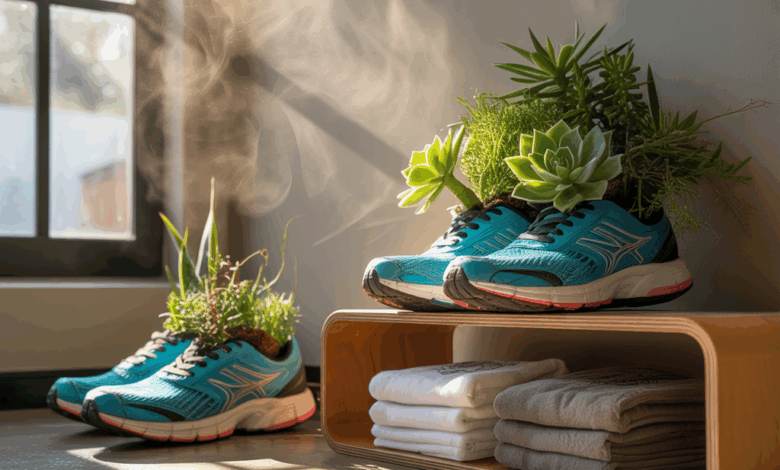What To Do With Old Running Shoes

Have you ever opened your closet and stared at a stack of scuffed, worn-out shoes wondering, “What should I do with these?” Whether they’ve lost their cushioning, the tread is gone, or they smell like a mile of hard runs, figuring out what to do with old running shoes is a common dilemma for every runner. Tossing them in a landfill feels wasteful, but keeping them around can hold you back from better performance and increase injury risk. Let’s explore practical, sustainable, and fitness-friendly solutions.
Why You Shouldn’t Keep Worn-Out Trainers Around
Old running shoes that have passed the 300–500 mile mark or show visible signs of wear can compromise your form, reduce shock absorption, and increase injury risk. Keeping them “just in case” might seem convenient, but switching to fresh shoes when needed helps prevent joint pain and improves performance. That said, worn shoes can still have a second life.
What to Do With Old Running Shoes
Here are smart and actionable ideas for used running shoes — from donating and recycling to repurposing them in workouts and around the house.
Donate or Rehome Them
- Local charities, community centers, or youth sports programs often accept gently used trainers. They help people who need footwear for walking or casual exercise.
- Consider giving them to friends or coworkers for light activities like walking or gym classes.
Recycle Through Specialized Programs
Many cities and national programs accept running shoes for recycling — they break down materials into playground surfaces, running tracks, or insulation. If a program exists in your area, it’s one of the most eco-friendly options.
Repurpose for Training and Cross-Training
Not all workouts need maximal cushioning. Use older shoes for:
- Short, easy recovery walks or treadmill strolls.
- Strength training (deadlifts, squats) where you might prefer flatter, more stable footwear.
- Short interval sessions or tempo runs where you don’t need the latest performance shoe — but be careful: if midsole compression is significant, prioritize safety.
Household and Outdoor Uses
- Gardening shoes: cut down on dirt in your favorite pair by assigning a durable old pair to yard work.
- Beach or lake shoes: older shoes can handle sand, water and rough terrain without worry.
- Emergency kit: keep a pair in your car or emergency bag for unexpected hikes or evacuations.
Creative Workout Ideas Using Old Running Shoes
Don’t underestimate the training value of worn-out trainers. Here are fitness tips and workout variations where old running shoes shine.
Strength Circuits
- Use old shoes for circuit training: kettlebell swings, lunges, and bodyweight drills. Their decreased cushioning can improve ground feel and stability for lifts.
- Try a full-body circuit: 3 rounds of 12 kettlebell swings, 10 goblet squats, 12 walking lunges, and 30 seconds plank — in your older trainers.
Trail Walks and Hilly Power Walks
Worn shoes can be ideal for non-technical trail walks and hill sprints where you’re not looking for marathon cushioning. Pair them with ankle-strengthening exercises to reduce injury risk.
Short Interval Runs (Use Caution)
If the midsole still offers decent support, you can use old shoes for short intervals (200–400m) focusing on form and turnover. Replace them for long runs where cushioning matters most.
How to Decide Between Reuse, Repair, and Replace
Follow these simple checks:
- Inspect the outsole: If the tread is dangerously worn, retire them from road use.
- Check midsole compression: If the foam won’t rebound, the shock absorption is gone.
- Look at upper integrity: Tears or broken eyelets might make repairs impractical.
If repairs are possible (new laces, insoles, gluing a sole), try them. Otherwise, shift to repurposing, donating, or recycling.
Real-World Examples: How Runners Reuse Old Sneakers
Jane, a weekend marathoner, saved her last pair to use for home strength sessions and yard work. She found the flatter feel improved her squat depth. Marcus, a coach at a local high school, collects gently used running shoes to gift to athletes who can’t afford new ones. Small choices like these extend the life of a shoe and help the community.
Maintenance Tips to Extend the Life of Your Running Shoes
- Rotate between two pairs to let foam recover between runs.
- Air them out after workouts and wash them by hand when needed.
- Use replaceable insoles to refresh comfort without buying a full pair.
Healthy Lifestyle Advice Related to Footwear Choices
Proper footwear supports your training schedule and overall well-being. Match shoes to the activity — stability shoes for overpronation, cushioned shoes for long runs, and minimalist shoes for strengthening drills. Combine good foot care with mobility work, calf raises, and ankle stability exercises to reduce injury risk and improve performance.
Frequently Asked Questions
1. Can I run in old running shoes for short distances?
Yes, if the midsole still provides support and the outsole isn’t dangerously worn. For easy short runs or intervals, older shoes can be acceptable. Avoid using compressed shoes for long runs where cushioning matters most.
2. Where can I recycle my used running shoes?
Look for local shoe-recycling programs, community drives, or sporting-goods stores that accept worn sneakers. If a formal program isn’t available, donating usable pairs to local charities is a great alternative.
3. How do I know when it’s time to replace my running shoes?
Replace shoes when they’ve logged about 300–500 miles, show midsole compression, have significant outsole wear, or start causing discomfort or new aches. Regularly check them to prevent injury from worn-out cushioning.
Conclusion: Make a Plan for Your Old Running Shoes
Deciding what to do with old running shoes doesn’t have to be stressful. Whether you donate, recycle, repurpose for workouts, or keep them as backups, each option helps you get more value and reduce waste. Start by assessing each pair, then choose the best path — donate usable ones, recycle those beyond repair, and repurpose any that are still functionally useful.
Ready to make a switch? Check your shoe mileage, pick one pair to retire, and try one of the ideas above. For more ways to improve your training and lifestyle, explore our workout routines and wellness tips. If you liked this guide, share your experience or ask a question below — and consider donating your next usable pair to someone who could use them.





